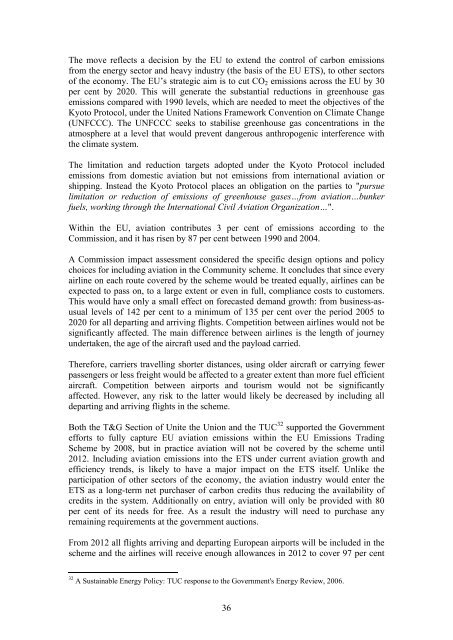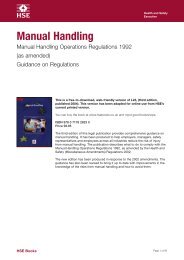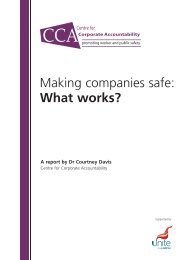Sustainable Transport and the Environment Guide - Unite the Union
Sustainable Transport and the Environment Guide - Unite the Union
Sustainable Transport and the Environment Guide - Unite the Union
You also want an ePaper? Increase the reach of your titles
YUMPU automatically turns print PDFs into web optimized ePapers that Google loves.
The move reflects a decision by <strong>the</strong> EU to extend <strong>the</strong> control of carbon emissions<br />
from <strong>the</strong> energy sector <strong>and</strong> heavy industry (<strong>the</strong> basis of <strong>the</strong> EU ETS), to o<strong>the</strong>r sectors<br />
of <strong>the</strong> economy. The EU’s strategic aim is to cut CO 2 emissions across <strong>the</strong> EU by 30<br />
per cent by 2020. This will generate <strong>the</strong> substantial reductions in greenhouse gas<br />
emissions compared with 1990 levels, which are needed to meet <strong>the</strong> objectives of <strong>the</strong><br />
Kyoto Protocol, under <strong>the</strong> <strong>Unite</strong>d Nations Framework Convention on Climate Change<br />
(UNFCCC). The UNFCCC seeks to stabilise greenhouse gas concentrations in <strong>the</strong><br />
atmosphere at a level that would prevent dangerous anthropogenic interference with<br />
<strong>the</strong> climate system.<br />
The limitation <strong>and</strong> reduction targets adopted under <strong>the</strong> Kyoto Protocol included<br />
emissions from domestic aviation but not emissions from international aviation or<br />
shipping. Instead <strong>the</strong> Kyoto Protocol places an obligation on <strong>the</strong> parties to "pursue<br />
limitation or reduction of emissions of greenhouse gases…from aviation…bunker<br />
fuels, working through <strong>the</strong> International Civil Aviation Organization…".<br />
Within <strong>the</strong> EU, aviation contributes 3 per cent of emissions according to <strong>the</strong><br />
Commission, <strong>and</strong> it has risen by 87 per cent between 1990 <strong>and</strong> 2004.<br />
A Commission impact assessment considered <strong>the</strong> specific design options <strong>and</strong> policy<br />
choices for including aviation in <strong>the</strong> Community scheme. It concludes that since every<br />
airline on each route covered by <strong>the</strong> scheme would be treated equally, airlines can be<br />
expected to pass on, to a large extent or even in full, compliance costs to customers.<br />
This would have only a small effect on forecasted dem<strong>and</strong> growth: from business-asusual<br />
levels of 142 per cent to a minimum of 135 per cent over <strong>the</strong> period 2005 to<br />
2020 for all departing <strong>and</strong> arriving flights. Competition between airlines would not be<br />
significantly affected. The main difference between airlines is <strong>the</strong> length of journey<br />
undertaken, <strong>the</strong> age of <strong>the</strong> aircraft used <strong>and</strong> <strong>the</strong> payload carried.<br />
Therefore, carriers travelling shorter distances, using older aircraft or carrying fewer<br />
passengers or less freight would be affected to a greater extent than more fuel efficient<br />
aircraft. Competition between airports <strong>and</strong> tourism would not be significantly<br />
affected. However, any risk to <strong>the</strong> latter would likely be decreased by including all<br />
departing <strong>and</strong> arriving flights in <strong>the</strong> scheme.<br />
Both <strong>the</strong> T&G Section of <strong>Unite</strong> <strong>the</strong> <strong>Union</strong> <strong>and</strong> <strong>the</strong> TUC 32 supported <strong>the</strong> Government<br />
efforts to fully capture EU aviation emissions within <strong>the</strong> EU Emissions Trading<br />
Scheme by 2008, but in practice aviation will not be covered by <strong>the</strong> scheme until<br />
2012. Including aviation emissions into <strong>the</strong> ETS under current aviation growth <strong>and</strong><br />
efficiency trends, is likely to have a major impact on <strong>the</strong> ETS itself. Unlike <strong>the</strong><br />
participation of o<strong>the</strong>r sectors of <strong>the</strong> economy, <strong>the</strong> aviation industry would enter <strong>the</strong><br />
ETS as a long-term net purchaser of carbon credits thus reducing <strong>the</strong> availability of<br />
credits in <strong>the</strong> system. Additionally on entry, aviation will only be provided with 80<br />
per cent of its needs for free. As a result <strong>the</strong> industry will need to purchase any<br />
remaining requirements at <strong>the</strong> government auctions.<br />
From 2012 all flights arriving <strong>and</strong> departing European airports will be included in <strong>the</strong><br />
scheme <strong>and</strong> <strong>the</strong> airlines will receive enough allowances in 2012 to cover 97 per cent<br />
32 A <strong>Sustainable</strong> Energy Policy: TUC response to <strong>the</strong> Government's Energy Review, 2006.<br />
36
















